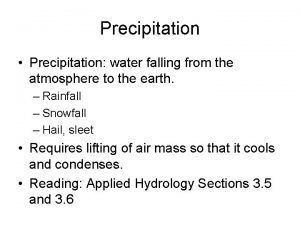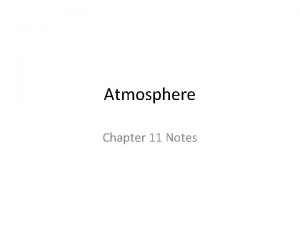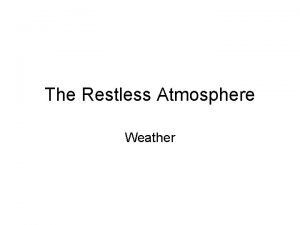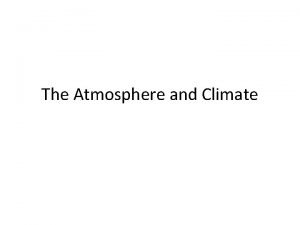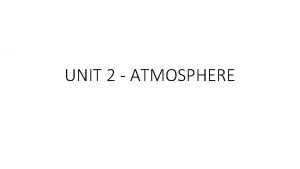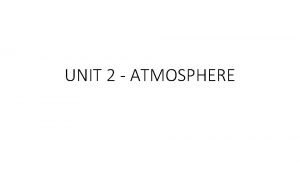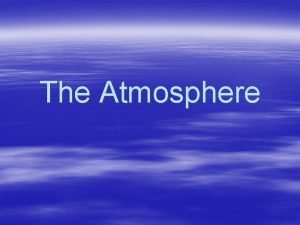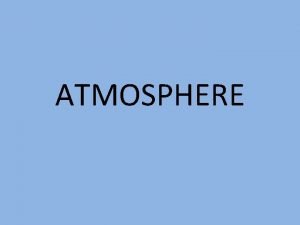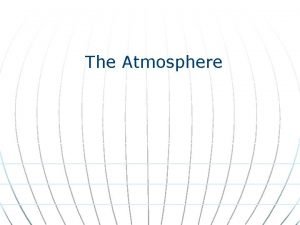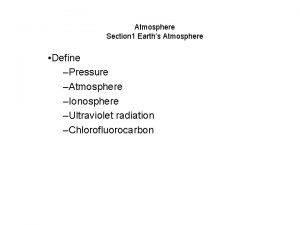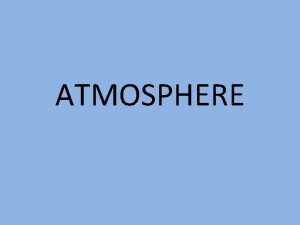Water in the Atmosphere Water in the Atmosphere














- Slides: 14

Water in the Atmosphere

Water in the Atmosphere • The Water Cycle

Humidity • Humidity is a measure of the amount of water vapor in the air. • The amount of water vapor that the air can hold depends on its temperature. • Warm air can hold more water vapor than cool air.

Humidity • The percentage of water vapor in the air compared to the maximum amount the air could hold is called the relative humidity.

• Relative humidity can be measured using a psychrometer.

Water in the Air • Clouds form when water vapor in the air becomes liquid water or ice crystals. • The process by which molecules of water vapor in the air become liquid water is called condensation.

Water in the Air • The temperature at which condensation begins is called the dew point. • Clouds form whenever air is cooled to its dew point and particles are present.

Types of Clouds • Meteorologists classify clouds into three main types (shapes): – 1. Cumulus – 2. Stratus – 3. Cirrus • Clouds are also classified by their altitude. • Each type of cloud is associated with a different type of weather.

Cumulus • Clouds that look like fluffy, rounded piles of cotton are called cumulus clouds. • Cumulus clouds usually indicate fair weather. • Towering clouds with flat tops, called cumulonimbus clouds, often produce thunderstorms.

Stratus • Clouds that form in flat layers are called stratus clouds. • As stratus clouds thicken, they may produce drizzle, rain, or snow. • They are then called nimbostratus clouds.

Cirrus • Wispy, feathery clouds are called cirrus clouds. • Cirrus clouds form only at high levels, where temperatures are very low. • As a result, cirrus clouds are made of ice crystals. • Cirrocumulus clouds often indicate that a storm is on its way.

Lenticular Clouds • Air gets pushed upward where it cools and condenses into clouds. • Depending on how smooth the flow is, you can get some amazing clouds formations

Mammatus Clouds

• Clouds that form at or near the ground are called fog • Fog often forms when the ground cools at night after a warm, humid day
 Water and water and water water
Water and water and water water It is the water falling from the atmosphere.
It is the water falling from the atmosphere. Water vapor in the atmosphere percentage
Water vapor in the atmosphere percentage Thẻ vin
Thẻ vin Các môn thể thao bắt đầu bằng tiếng đua
Các môn thể thao bắt đầu bằng tiếng đua Tư thế ngồi viết
Tư thế ngồi viết Cái miệng nó xinh thế chỉ nói điều hay thôi
Cái miệng nó xinh thế chỉ nói điều hay thôi Hình ảnh bộ gõ cơ thể búng tay
Hình ảnh bộ gõ cơ thể búng tay Cách giải mật thư tọa độ
Cách giải mật thư tọa độ Từ ngữ thể hiện lòng nhân hậu
Từ ngữ thể hiện lòng nhân hậu Trời xanh đây là của chúng ta thể thơ
Trời xanh đây là của chúng ta thể thơ Tư thế ngồi viết
Tư thế ngồi viết Ví dụ giọng cùng tên
Ví dụ giọng cùng tên Gấu đi như thế nào
Gấu đi như thế nào Thể thơ truyền thống
Thể thơ truyền thống

